Did you know that in traditional Filipino culture, a person could have multiple souls? For instance, the Ifugao people believe in two souls—one in the eyes and one in the breath. This unique view highlights the deep connection between the body and the spiritual realm in Filipino beliefs.
In many indigenous Filipino cultures, the soul is seen as more than just a part of a person—it’s a vital force that shapes life and existence. The body, often viewed as a vessel, plays a crucial role in this belief system. Rituals and practices are designed to maintain harmony between the body and the soul, ensuring well-being and balance.
These traditions reflect a belief in immortality and the idea that the soul continues its journey even after death. From the Tagalog’s kaluluwa to the Bukidnon’s seven souls, these concepts reveal a rich tapestry of spiritual understanding that has shaped Filipino culture for centuries.
Key Takeaways
- Traditional Filipino cultures often believe in multiple souls per person.
- The body is viewed as a vessel that houses the soul.
- Rituals and practices maintain harmony between body and soul.
- Beliefs in immortality and the afterlife are central to these traditions.
- Different ethnic groups have unique terms and concepts for the soul.
Introduction to Ancient Filipino Beliefs
Ancient Filipino beliefs offer a fascinating glimpse into the spiritual world. These traditions explore the essence of existence, focusing on the soul as a vital part of life. In many indigenous cultures, the soul is seen as an immaterial essence that shapes a person’s character and journey.
The body is often viewed as a vessel that houses the soul. This concept highlights the connection between the physical and spiritual realms. Traditional practices aim to maintain harmony between the two, ensuring balance and well-being.
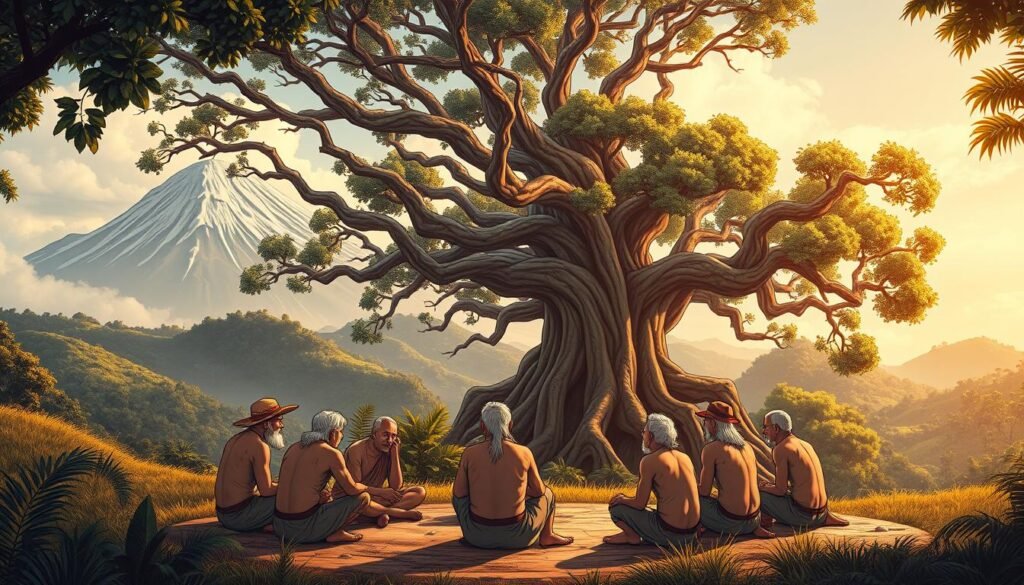
The origin of the soul remains a mystery in many Filipino beliefs. Indigenous systems of thought suggest that the soul takes a specific form, integral to one’s life. This idea is supported by rituals and practices that honor the soul’s journey.
Filipino beliefs also connect to broader cultural influences. For example, urban centers like New York showcase how spiritual traditions evolve in modern settings. Nature and material elements further shape these beliefs, reflecting a deep respect for the environment.
Here are some key aspects of ancient Filipino beliefs:
- The soul is an immaterial essence that defines a person’s character.
- The body serves as a vessel for the soul, maintaining harmony.
- Traditional practices support the mystery of the soul’s origin.
- Cultural influences, like nature and urban life, shape these beliefs.
Historical Perspectives on the Soul in Filipino Culture
In early Filipino history, the concept of the soul was deeply intertwined with animistic beliefs. Indigenous communities viewed the soul as a vital force that connected the physical and spiritual worlds. This belief shaped their daily life and rituals, emphasizing harmony between the body and the soul.
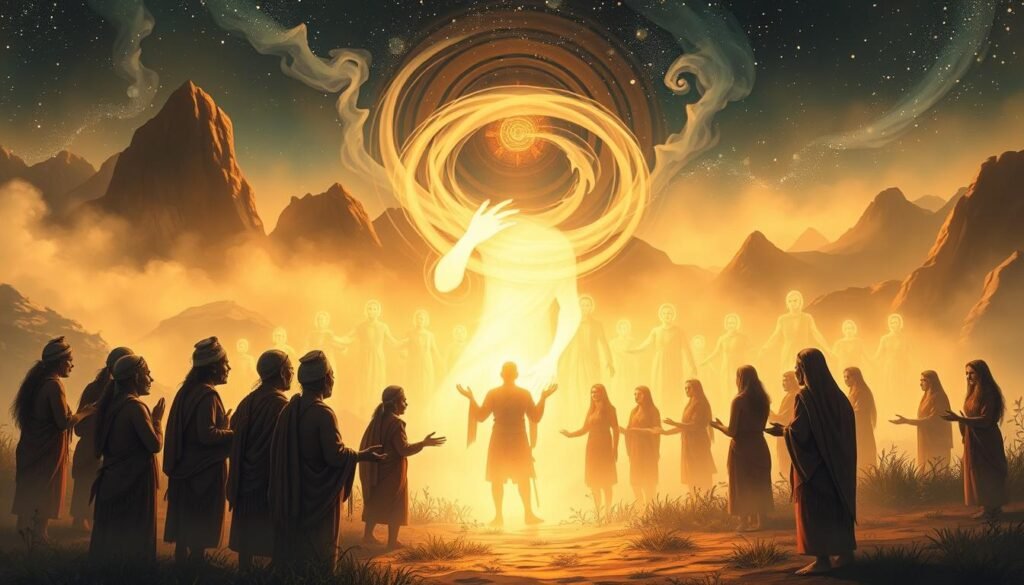
Early Indigenous Traditions and Animism
Before colonial influences, Filipino cultures were rooted in animism. The soul was seen as an immaterial essence that defined a person‘s identity. For example, the Ifugao people believed in multiple souls, each tied to different aspects of life.
Communal teachings played a significant role in shaping these beliefs. A teacher or elder would guide the community in understanding the soul’s role in rituals and daily activity. These practices ensured a balance between the physical and spiritual realms.
Colonial Influences and Evolving Beliefs
With the arrival of colonial powers, Filipino beliefs about the soul began to shift. The concept of the soul was reinterpreted through the lens of Christianity. This introduced a new perspective, blending indigenous traditions with imported ideas.
For instance, the state of the soul after death became a central focus. Traditional narratives, such as those surrounding birth and the afterlife, were adapted to fit these evolving beliefs. This fusion of ideas continues to shape Filipino spirituality today.
| Aspect | Pre-Colonial Beliefs | Post-Colonial Beliefs |
|---|---|---|
| View of the Soul | Multiple souls tied to nature | Single soul influenced by Christianity |
| Role of Rituals | Maintain harmony with nature | Focus on salvation and afterlife |
| Community Role | Elders as spiritual guides | Priests and religious leaders |
The Concept of the Soul in Global Traditions
Across cultures, the concept of the soul has been a central theme in understanding life and existence. From ancient Egypt to Eastern philosophies, the soul is often seen as a mysterious thing that defines a person’s personality and journey. These traditions offer unique perspectives on the body and its connection to the spiritual realm.

Religious and Philosophical Comparisons
In ancient Egyptian religion, the soul was believed to consist of multiple elements, each tied to different aspects of life. This complex view reflects a deep understanding of the body as a vessel for spiritual energy. Similarly, in Buddhism, the doctrine of anatman challenges the idea of a permanent soul, emphasizing impermanence and interconnectedness.
In contrast, the Baháʼí Faith teaches that the soul is immortal, continuing its journey beyond physical death. This belief aligns with the view of many cultures that the soul is essential for achieving higher states of development. These diverse perspectives highlight the universal effort to explain the reality of existence.
From Ancient Egypt to Eastern Thought
Ancient Egyptian traditions often depicted the soul as a blend of physical and spiritual elements. This system of thought influenced later cultures, including those in the world of Eastern philosophy. For example, in Hinduism, the concept of ātman emphasizes the soul’s role in achieving liberation (moksha).
In Confucian traditions, the soul is divided into spiritual and corporeal aspects, reflecting a nuanced understanding of human existence. These ideas resonate with the belief systems found in urban centers like York, where cultural influences shape modern interpretations of the soul.
| Tradition | View of the Soul | Key Concept |
|---|---|---|
| Ancient Egypt | Multiple elements | Complex spiritual energy |
| Buddhism | No permanent soul | Impermanence |
| Baháʼí Faith | Immortal soul | Afterlife journey |
| Hinduism | Ātman | Liberation (moksha) |
Indigenous Spirit World: Filipino Cosmology
Filipino cosmology paints a vivid picture of the spirit world, where the journey of the soul is central to understanding life and existence. This belief system reflects a deep connection between the physical and spiritual realms, shaping cultural traditions and practices.
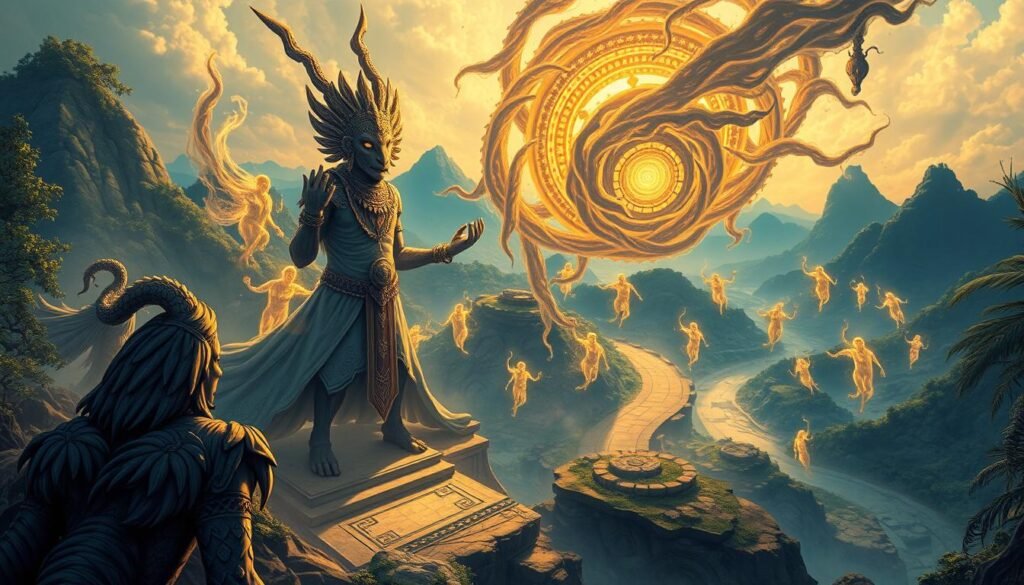
The journey of the soul begins at its origin and continues through life, with the body serving as a vessel for this spiritual voyage. Each person holds a unique concept of destiny, supported by cultural references that span from rural traditions to urban centers like New York.
Time and life are interwoven in this narrative, marking critical milestones in the soul’s progress. Belief in immortality fuels this journey, with rituals and activity playing a vital role in maintaining harmony between the physical and spiritual realms.
“The soul’s journey is not just a personal experience but a reflection of the collective spirit of the community.”
This journey includes pivotal moments when the soul comes into awareness, revealing an important aspect of its existence. These moments are often marked by rituals that honor the soul’s progress and its destined state.
Filipino cosmology offers a unique view of the spirit world, emphasizing the soul’s journey as a key aspect of life. This belief system continues to shape cultural practices and traditions, reflecting a deep respect for the spiritual realm.
Rituals and Ceremonies Connecting to the Spirit World
Rituals and ceremonies in Filipino culture serve as bridges between the physical and spiritual worlds. These practices are deeply rooted in tradition, offering a sense of connection to ancestral wisdom and the unseen realm. They celebrate life and its transitions, marking important milestones with reverence.
One key idea behind these rituals is the belief that the body is a vessel for spiritual energy. Through ceremonies, individuals honor this connection, fostering a view of existence that integrates the physical and the metaphysical. This concept is central to many indigenous practices.
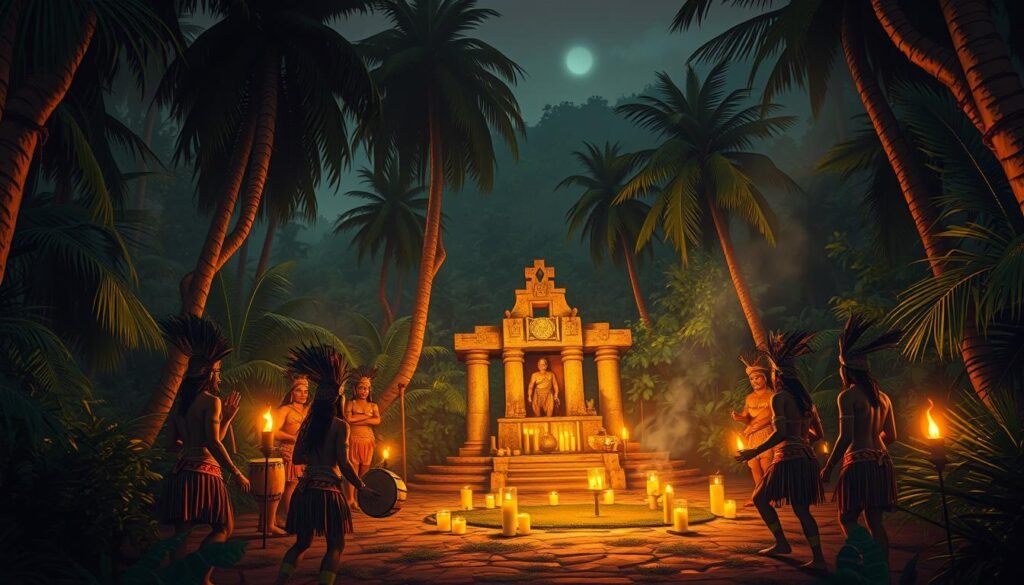
In some communities, rituals are taught in local schools of tradition, ensuring their preservation. These practices often involve specific actions, such as offerings or dances, that carry the essence of cultural identity. They also reinforce communal bonds, bringing people together in shared purpose.
“Ceremonies are not just acts of tradition; they are expressions of our deepest connections to the spiritual world.”
These rituals also play a vital role in personal development. They provide a space for reflection and healing, helping individuals navigate life’s challenges. By participating, people gain a deeper understanding of their place in the world and their relationship to the spirit realm.
For those interested in exploring these traditions further, learning about ancient Filipino scripts can offer additional insights into the cultural roots of these practices.
Artistic Interpretations: From Ancient Art to Modern Animation
Art has always been a powerful medium to explore the mysteries of the soul and the spirit world. From ancient carvings to modern animations, artists have used their craft to express the intangible essence of life and existence. These interpretations offer a unique view of how cultures perceive the connection between the physical and spiritual realms.
Traditional Icons and Symbols
In ancient Filipino art, the body often served as a canvas for spiritual symbols. Tattoos, carvings, and pottery depicted the soul as a vital force, intertwined with nature and ancestral spirits. These icons were not just decorative but carried deep cultural significance, reflecting a collective concept of the spiritual journey.
For example, the intricate designs on traditional banig (woven mats) often symbolized the cycle of life and the eternal nature of the soul. These patterns were passed down through generations, preserving a rich artistic heritage that continues to inspire modern creators.
Contemporary Representations in Film and Art
Modern Filipino artists and filmmakers have embraced these ancient themes, reinterpreting them for today’s audiences. Films like “Anito” and artworks by contemporary creators explore the body as a vessel for spiritual energy, blending traditional motifs with new techniques.
Animation, in particular, has become a popular medium to depict the world of spirits and the immortality of the soul. These works often use vibrant colors and dynamic movements to convey the ethereal nature of the spirit realm, creating a visual language that resonates with viewers of all ages.
| Aspect | Traditional Art | Modern Art |
|---|---|---|
| Medium | Tattoos, carvings, pottery | Film, animation, digital art |
| Theme | Connection to nature and ancestors | Exploration of spiritual energy |
| Technique | Handcrafted, symbolic patterns | Digital tools, vibrant colors |
Through these artistic expressions, the body remains a central symbol, bridging the gap between the physical and spiritual worlds. Whether through ancient carvings or modern animations, the view of the soul as a timeless essence continues to captivate and inspire.
For more insights into the evolution of artistic traditions, explore the history of art and its profound impact on cultural narratives.
Beliefs about Life, Death, and Rebirth in Filipino Culture
Filipino culture holds a profound belief in the cycles of life, death, and rebirth, shaping the spiritual identity of its people. These beliefs are deeply rooted in indigenous traditions, emphasizing the soul’s journey through existence. The body serves as a vessel for this spiritual voyage, marking transitions that are both physical and metaphysical.
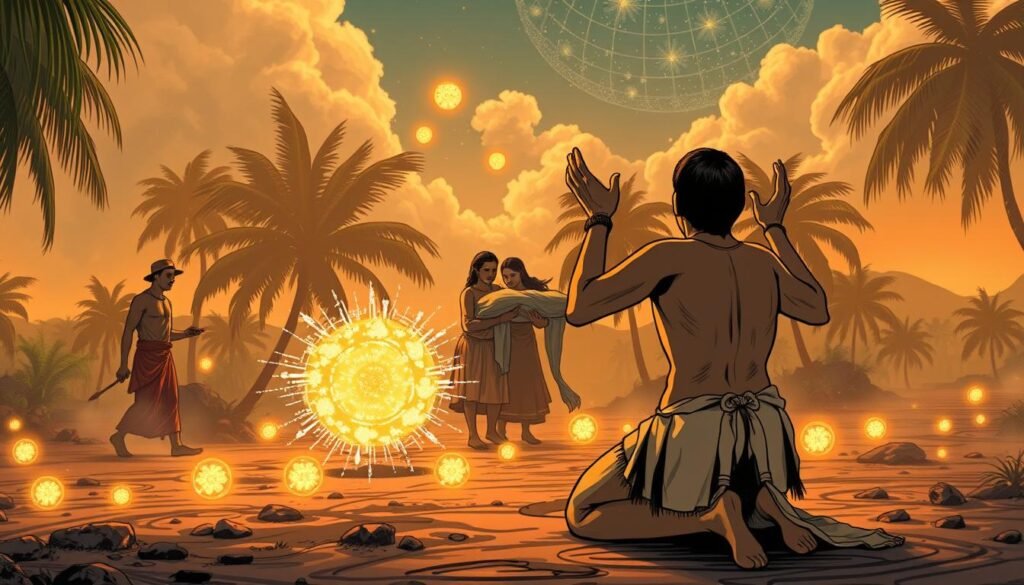
Concepts of Transition and Renewal
In Filipino cosmology, life and death are seen as interconnected phases of a continuous cycle. The idea of renewal is central to this view, with each phase offering opportunities for growth and transformation. The body plays a crucial role in this process, acting as the stage for the soul’s journey.
Reincarnation is a key concept in many indigenous narratives. It reflects the belief that the soul returns in a new form, carrying lessons from past lives. This cycle contributes to the formation of character, shaping the individual’s personality and destiny.
Role of Ancestral Spirits in Guiding Souls
Ancestral spirits hold a significant place in Filipino beliefs about life and death. They are seen as guides who help the soul navigate its journey. This belief is rooted in the origin of these traditions, where ancestors were revered as protectors and mentors.
In modern contexts, such as urban centers like York, these traditions continue to influence cultural practices. They serve as a bridge between the past and the present, upholding traditional values while adapting to contemporary realities.
“The soul’s journey is not just a personal experience but a reflection of the collective spirit of the community.”
| Aspect | Traditional View | Modern View |
|---|---|---|
| Life Cycle | Cyclical, with emphasis on renewal | Blends traditional and contemporary beliefs |
| Role of Body | Vessel for spiritual transitions | Symbol of physical and spiritual harmony |
| Ancestral Spirits | Guides and protectors | Cultural mentors in urban settings |
These beliefs are reinforced through efforts inspired by figures like Paul, who have worked to preserve and promote indigenous narratives. They highlight the reality of these traditions, offering a systematic framework for understanding life, death, and rebirth.
For a deeper exploration of these themes, learn about the flood myths among various tribes, which illustrate the cyclical nature of existence in Filipino culture.
Spiritual Practices and Healing Traditions in the Philippines
Traditional Filipino healing methods blend physical and spiritual elements to restore balance. These practices, deeply rooted in cultural heritage, emphasize the connection between the body and the unseen world. Through rituals and ceremonies, healers aim to revitalize the soul and bring harmony to a person‘s life.

Shamanism plays a central role in these traditions. A revered teacher, often an albularyo, guides the healing process. They use a combination of herbal remedies, prayers, and rituals to address both physical and spiritual ailments. This view of healing reflects a holistic concept of well-being, where the body serves as a canvas for spiritual restoration.
Shamanism and Ritual Healing
In Filipino shamanism, the healer acts as a bridge between the physical and spiritual realms. They perform rituals that often involve offerings, chants, and the use of sacred objects. These activities aim to restore the state of balance and provide a sense of renewal. For example, a man might visit a sacred place like Mount Banahaw to seek healing, believing in its powerful spiritual energy.
One common practice is the tawas ritual, where candle wax is melted in water to diagnose illnesses. This method, rooted in pre-colonial traditions, highlights the deep connection between the body and the spirit. Healers also use herbs like sambong and lagundi, which have been scientifically validated for their medicinal properties.
“Healing is not just about the body; it’s about restoring the spirit and connecting with the natural world.”
These traditions continue to evolve, blending indigenous practices with modern influences. Today, many Filipinos turn to albularyos for their holistic approach to health, especially in rural areas with limited access to modern medicine. This new wave of interest reflects a growing appreciation for the wisdom of traditional healing.
| Aspect | Traditional Healing | Modern Healing |
|---|---|---|
| Focus | Spiritual and physical balance | Scientific and clinical methods |
| Practitioners | Albularyos, shamans | Doctors, nurses |
| Methods | Rituals, herbs, prayers | Medications, surgeries |
| Philosophy | Holistic, interconnected | Specialized, symptom-focused |
For those interested in exploring these traditions further, Filipino healing traditions offer a rich tapestry of practices that connect nature, spirituality, and community. These methods continue to shape the cultural identity of the Philippines, preserving ancient wisdom in a modern world.
Exploring the “Soul” in Filipino Folklore
Filipino folklore is rich with tales that delve into the mysteries of the spirit and its connection to the physical world. These stories often highlight the soul as a central theme, weaving it into myths and legends that have been passed down through generations. From the Tagbanuwa of Palawan to the Hanunoo Mangyans of Mindoro, each culture offers a unique view of the soul’s role in life and beyond.
One recurring idea in these narratives is the body as a vessel for the soul. For example, the Ilocanos believe in multiple souls, each tied to different aspects of existence. This concept reflects a deep understanding of the interplay between the physical and spiritual realms. Such tales not only entertain but also shape cultural identity, offering insights into how Filipinos perceive the world.

Institutions like schools play a vital role in preserving these stories. Through oral traditions and modern education, the effort to maintain these narratives ensures they remain alive for future generations. These tales often feature pivotal moments when the soul comes to life, revealing its importance in shaping a person’s journey.
For those interested in a deeper dive into these traditions, the Filipino Phenomenology of Soul offers a comprehensive exploration of how these beliefs intersect with cultural practices.
Filipino folklore continues to evolve, blending ancient wisdom with new interpretations. Whether through the motif of an immortality soul or the emergence of a character in a myth, these stories remain a testament to the enduring power of cultural storytelling.
Modern Research and Perspectives on the Filipino Soul
Modern research offers fresh insights into the Filipino soul, blending tradition with contemporary studies. Scholars today are exploring the soul from multidisciplinary perspectives, shedding light on its historical and cultural significance. This view highlights how the body serves as a vessel for spiritual energy, shaping societal understanding.
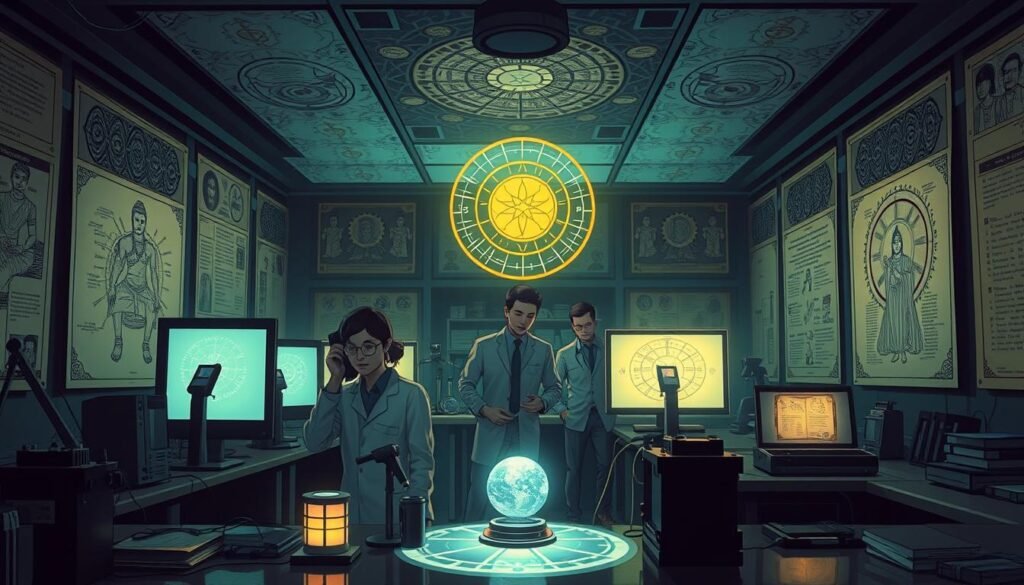
Academic studies emphasize the role of time and life in shaping these beliefs. For example, research by Paul and others examines how the concept of the soul’s immortality has evolved. These findings challenge traditional narratives while enriching our knowledge of Filipino spirituality.
Student-led investigations provide concrete examples of how these beliefs influence daily life. One example is the study of rituals that honor the body as a sacred vessel. These actions reflect a deep connection between physical and spiritual realms.
“The soul’s journey is not just a personal experience but a reflection of the collective spirit of the community.”
Emerging research also explores the contributions of figures like Paul, whose work bridges traditional and modern views. This state of inquiry reinforces the prevailing belief in the soul’s enduring significance. For a deeper dive into these themes, explore the anthropological insights on the Filipino soul.
In conclusion, modern research is reshaping our understanding of the Filipino soul. By blending tradition with contemporary studies, scholars are uncovering new layers of meaning that enrich our cultural heritage.
Conclusion
The Filipino understanding of the spirit world offers a unique lens into the connection between life and the unseen. Throughout history, the body has been viewed as a vessel for spiritual energy, shaping cultural practices and beliefs. This view reflects a deep respect for the interplay between the physical and metaphysical realms.
Modern research continues to explore this concept, blending traditional wisdom with contemporary insights. The idea of immortality remains central, influencing how communities perceive the journey of the soul. From ancient rituals to modern activities, these traditions highlight the essence of Filipino spirituality.
For a deeper understanding of these themes, explore the ancient soul and its evolution across cultures. This reality of spiritual connection continues to shape Filipino identity, offering profound insights into the nature of existence.
FAQ
What are the core beliefs about the soul in ancient Filipino culture?
Ancient Filipino beliefs centered on animism, where the soul was seen as a vital force in all living things. They believed in a spirit world where souls journeyed after death, guided by ancestral spirits.
How did colonial influences shape Filipino beliefs about the soul?
Colonial periods introduced Christianity, blending indigenous animistic beliefs with new religious ideas. This fusion created a unique perspective on the soul, immortality, and the afterlife.
How does Filipino cosmology describe the journey of the soul?
Filipino cosmology often depicts the soul’s journey as a transition through various realms, influenced by rituals and the guidance of ancestral spirits to ensure safe passage.
What role do rituals play in connecting to the spirit world in Filipino culture?
Rituals and ceremonies serve as bridges between the physical and spirit worlds. They honor ancestors, seek guidance, and ensure harmony between the living and the departed.
How are Filipino beliefs about the soul represented in art and media?
Traditional art uses symbols like ancestral icons, while modern media, such as films and animations, reinterpret these beliefs to reflect contemporary cultural identity.
What are the key concepts of life, death, and rebirth in Filipino culture?
Filipino beliefs emphasize the cyclical nature of existence, where death is a transition rather than an end. Ancestral spirits play a crucial role in guiding souls through this process.
How do spiritual practices like shamanism connect to the soul in the Philippines?
Shamanism involves ritual healing and communication with the spirit world. Shamans act as intermediaries, helping individuals maintain balance and harmony with their soul and the universe.
What does modern research reveal about the Filipino concept of the soul?
Academic studies explore the evolution of these beliefs, highlighting their cultural significance and how they continue to shape Filipino identity in a globalized world.
Source Links
- Souls in Filipino cultures
- Indigenous Philippine folk religions
- The Soul According to the Ethnolinguistic Groups of the Philippines • THE ASWANG PROJECT
- Filipino Traditions and Practices on All Souls’ Day
- Undas: A Unique Tradition of Honoring the Dead in the Philippines
- Exploring the Pre-Colonial Concept of the Soul in the Philippines • THE ASWANG PROJECT
- Death and Dying: A Filipino American Perspective
- Filipino American National Historical Society Journal
- Soul
- Philosophical anthropology – Soul, Mind, Body | Britannica
- The Best Times for Spiritual Ceremonies & Rituals | Self Growth | Cleansing | Releasing — Adventuring with Poseidon Wellness | Spiritual Mentor
- Invoking Spirit and the Power of Ritual – Sounds True
- Greek and Roman Art and Architecture
- Ancient Art – A Glimpse into the Past
- Philosophy of art – Aesthetic, Moral, Expression | Britannica
- The Concept of Death, Resurrection, and Afterlife in Panay Epic Tradition
- Understanding Folk Religiosity in the Philippines
- Diversity in Dying: Death across Cultures
- Indigenous Filipino healing practices – Cold Tea Collective
- Episode 23 – Filipino Healing Traditions w/ Herbalaria
- Exploring The Ancient Healing Practices Of Philippine Albularyos: Blending Tradition, Herbs, And Spiritual Wisdom – MemoryCherish
- Anito
- American Vessels, Filipino Spirit (Chapter 7) – The Foundations of the Modern Philippine State
- What is the human soul?
- Soul | Religion, Philosophy & Nature of Being | Britannica

